Acadia National Park is full of natural beauty. From the rocky, coastal views to mountain summits, you’ll find a lot to see and a lot to do. As you make your way through the park, you’ll inevitably find yourself on Park Loop Road. As the name suggests, this road loops through the park on a one way road taking you past some of the top sights of Acadia National Park.
Since every visitor to the park is likely to find themselves on the road at some point, I thought I’d compile a list of the spots that you can’t miss on your visit.
The Best Stops Along Acadia’s Park Loop Road
Like all of my lists, this is not a comprehensive list of every single stop you can make along Acadia’s Park Loop Road. Rather, it’s a list of my favorite stops. When I visited, I stopped at several other viewpoints and they just didn’t wow me enough to warrant a spot on this list. So this is what I feel is the best of the best of Park Loop Road.
As always, this list is in no particular order.
Beehive Trail
The first stop I want to mention is the Beehive Trail which is one of the most popular hikes at Acadia National Park. You’ll rock scramble your way up a mountain for fantastic views of the ocean and the surrounding forest. The hike is adventurous with plenty of rock scrambling and even metal rungs bolted into the mountain to help you make your way up to the top. Even with all of this adventure, the Beehive Trail is not long. I logged 1.6 miles and 500 feet of elevation gain. It took me about an hour and 10 minutes to complete my hike.
Because of its popularity, parking for the Beehive Trail can fill up. There’s a large lot nearby at Sand Cove (covered next), but cars will also park along the road when that lot fills up. Be prepared for plenty of other hikers on the trail. Also, depending on when you arrive, be prepared to add a bit of extra road walking to reach the trailhead.
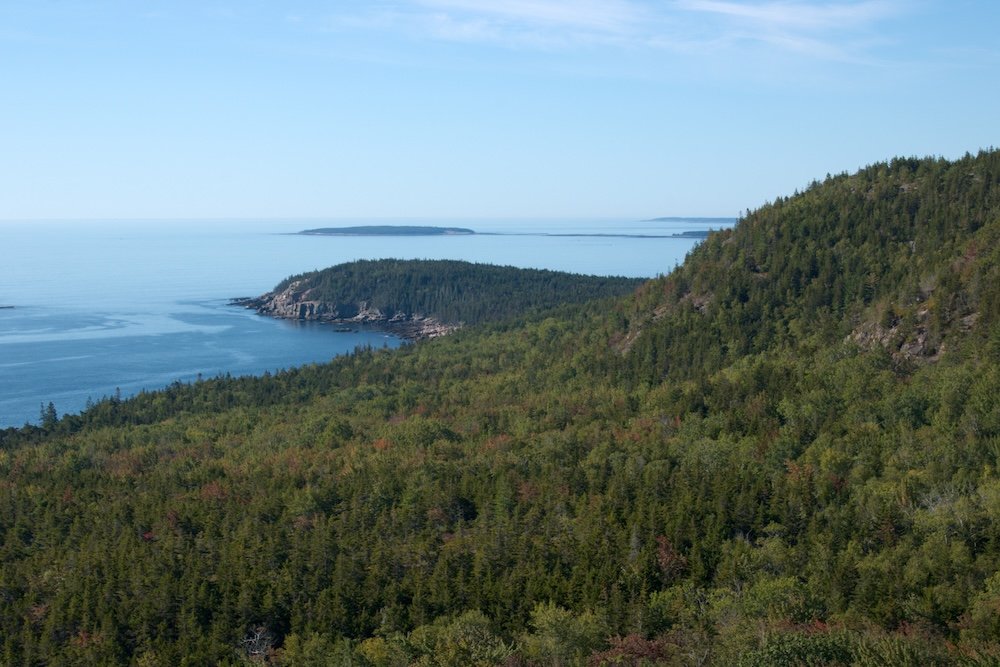
Sand Cove
Also located near the Beehive Trail is Sand Cove. I’d argue that the Beehive Trail is more popular but if you head away from the mountain and toward the ocean, you’ll find a nice, small beach. Unlike so many of the other coastal views along Acadia, this is a sand beach making it a bit easier for some fun. Even with the sand, you’ll still find the famous rocky cliffs on both edges of the beach.
Whether you stop here for some fun on the beach or for a nice view after your hike to the Beehives, this is a great stop along Park Loop Road.
Schooner Head
Schooner Head is another stop on Park Loop Road that’s well worth a visit. When you reach the parking lot, you might think “ok, this is a nice view”. But do a little better and take the path from the parking lot down to the rocks and the ocean. Rock scramble for a nice view along the Atlantic Ocean.
While Cadillac Mountain is famous for its sunrises, you’ll need a reservation to make it to the top of the mountain. For those without a reservation, I think Schooner Head would be another great sunrise option.
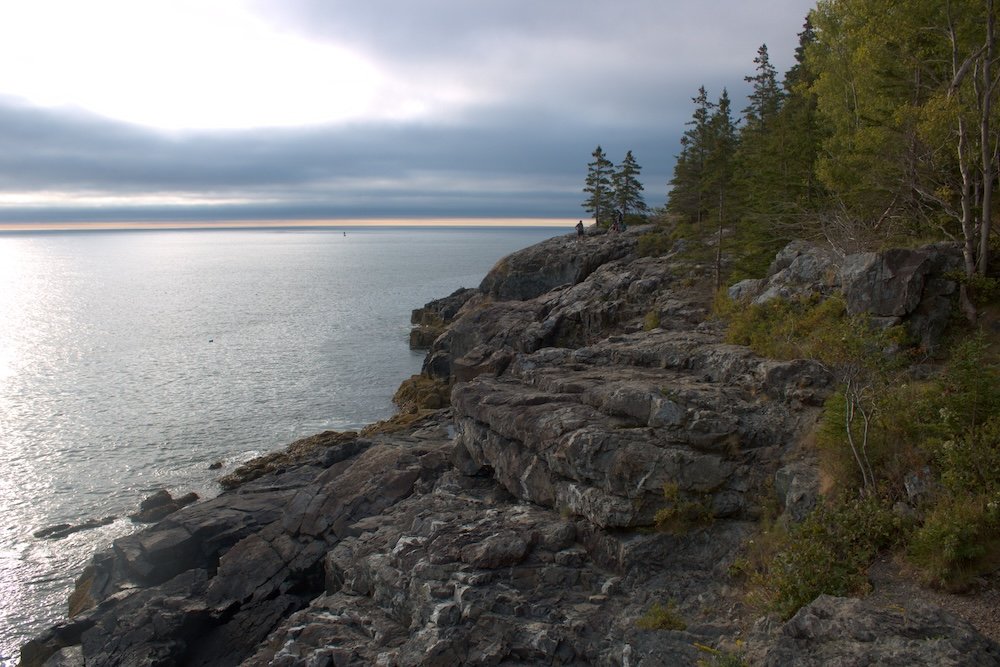
Jordan Pond
Let’s get back to some hiking along Park Loop Road. The next hiking opportunity that I want to mention is Jordan Pond. There’s numerous trails here and it’s your pick of what you want to hike. The most popular, and easiest, trail is to the loop around Jordan Pond. It’s mostly flat (though there can be a bit of uneven terrain) and gives you great views from all different angles.
The Jordan Cliffs follow the western side of the pond and offer a strenuous, adventurous trail. Be prepared for what feels like never-ending rock scrambling and a serious workout for your quads (my legs took a few days to feel normal again). My only complaint with the Jordan Cliffs is that it’s a strenuous trail and while I got a few nice views, there was nothing that was decidedly a “wow!”. You could continue all the way up Penobscot Peak where you’d likely get some great views, but my legs were exhausted at this point and I still had another climb to do later in the day.
You can also use the Jordan Pond Path to reach the Bubbles which is on the northeastern side of Jordan Pond. There are other trailheads but if you’re already looping around Jordan Pond, it’s easy to add a detour to the South Bubble. That said, the trail itself is not easy and you’ll climb about 600 feet to reach the south Bubble. In addition, I found the northern section of the trail much easier than the southern section.
If I were to hike this area again, I’d skip the Jordan Cliffs. From the Jordan Pond Trailhead, I’d head east and do the trail counter clockwise. Scramble up the rocks to the South Bubble before descending down a trail that feels more rock stairs than rock scramble. Then from the north side of Jordan Pond, enjoy the view before following the trail along the western side of Jordan Pond.
How much you hike is up to you, but I highly recommend including a stop at Jordan Pond on your drive around Park Loop Road.
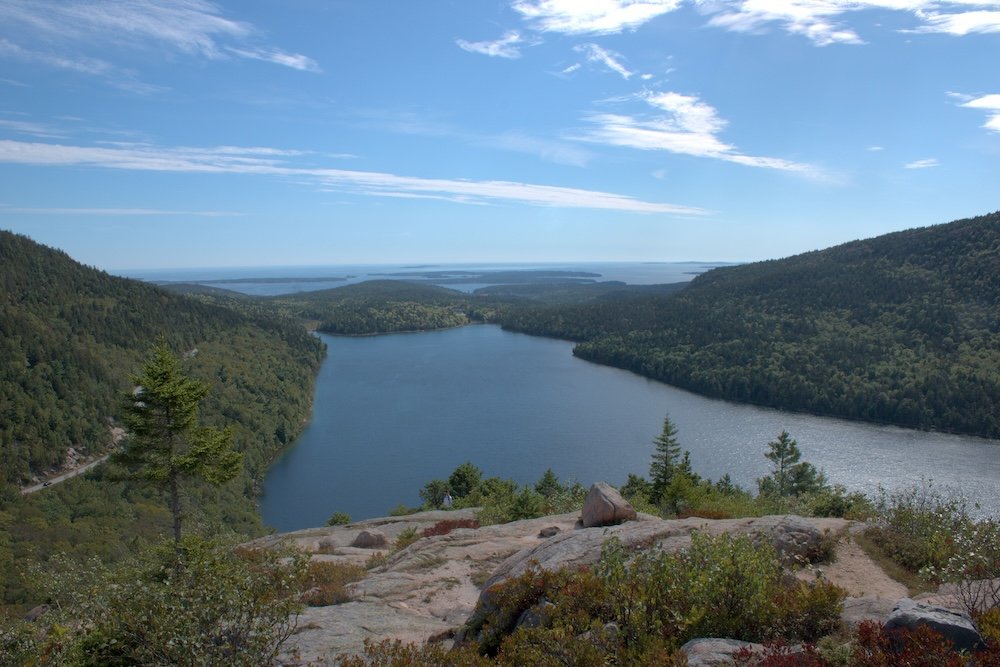
Otter Cliffs
If you look on Google Maps, you’ll see both an Otter Cliffs viewpoint and an Otter Point viewpoint. They are very close to each other and while I don’t think you need to stop at both, I would highly recommend stopping at one. If I had to choose, I think I preferred the Otter Point Overlook to the Otter Cliffs Overlook, but again, you can’t go wrong with either.
At these overlooks, you’ll find rocky cliffs and ocean views. Yes, there’s plenty of those throughout Acadia National Park, but I really enjoyed the views here. And if you’re up for a rock scramble, you could actually rock scramble your way from one viewpoint to the next (or take the more stable Ocean Path).
Eagle Lake
Eagle Lake has another great overlook, though I don’t know if it’s my favorite of the overlooks I’ve already described. Eagle Lake is just a bit north of Jordan Pond and while it’s very nice, I didn’t feel the need to linger here like I did at so many of the other views along Park Loop Road.
Still, a stop at Eagle Lake can be quick so include it on your visit into or out of the park.
Thunder Hole
Thunder Hole is an interesting stop on Park Loop Road because it’s not just about seeing something cool, it’s about hearing something cool. This hole in the rock amplifies the waves as the tide comes in providing loud booms. If you’re here during high tide, you’ll really understand why it gets the name of Thunder Hole.
If you aren’t here at high tide, you can still plan a stop. It may not be as dramatic as it is at high tide you can still experience the boom. When I visited, high tide was around 3:30 am (so I definitely wasn’t visiting then) and 3:45 pm (when I was in a very different area of the park), so I ended up here closer to low tide. If you have enough patience, you can wait for a few waves to give you a loud boom. Is it the same as what it would be at high tide? No, but you can get a bit of an idea of how much more powerful it is at high tide.
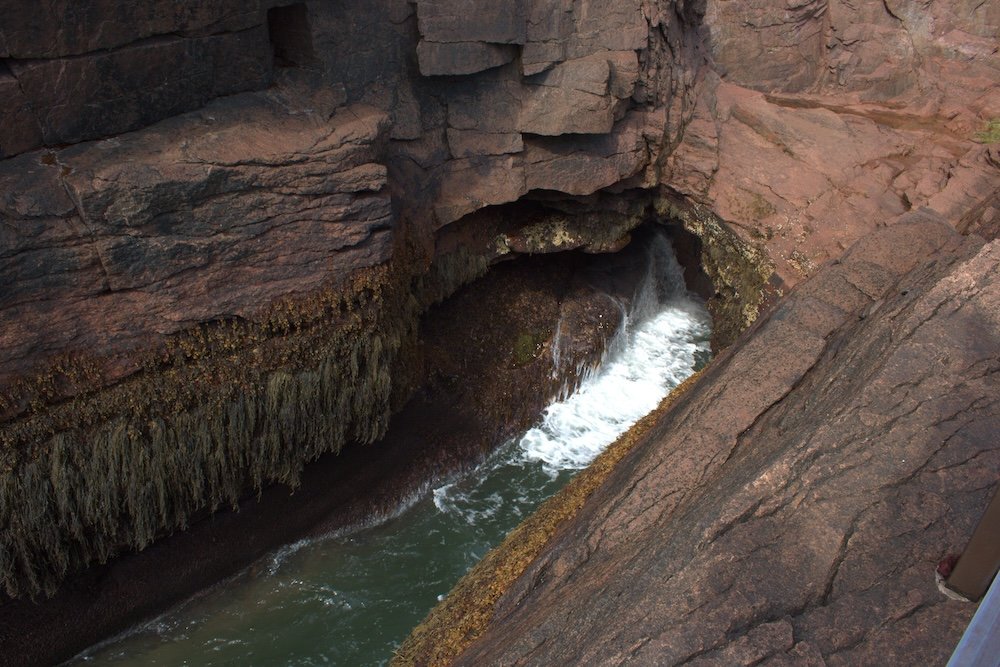
Western Point
Western Point is another quick stop for an overlook with nice coastal views. It is nice, and because it can be quick, I think it’s worth a stop. That said, I don’t know if I can say it’s definitively better than any of the other overlooks on this list. Though it is definitely better than some of the overlooks that I’ve excluded from my list.
Wild Gardens of Acadia
The Wild Gardens of Acadia is not along the coast, so it offers something a bit different. The Wild Gardens are near Suier de Monts which is where Acadia National Park was founded. Before it was Acadia National Park, it was Suier de Monts National Monument. Now, in this area, you’ll find a nature center and gardens with dedicated pathways showcasing local flora.
I tried to stop here, but they were closed at the time (the gardens are open from 9:00 am to 5:00 pm). I could see them from the outside and they looked nice, so if you want to stop, make sure to plan your time accordingly.
Cadillac Mountain
Park Loop Road could be considered a scenic drive, but Cadillac Mountain definitely is one. While there are options to hike up the mountain, many visitors choose to drive the mountain. Along the way, there are pullouts and overlooks offering nice views of the surrounding area. Up at the summit, you’ll find even more views.
I presume the views at the top are amazing, but I came for sunrise and the weather didn’t quite cooperate. I saw a little bit when I first arrived, but then the fog rolled in and we couldn’t see anything from the top of the mountain, which was a bummer. Still, I stopped at some of the overlooks on the way down and those were pretty nice.
In order to drive Cadillac Mountain, you’ll need to purchase an entry ticket. You can either purchase one for sunrise or for a twenty minute interval throughout the day. You must enter during the time marked on your ticket, but you can stay as long as you want. Learn more with my guide to National Park Reservations.
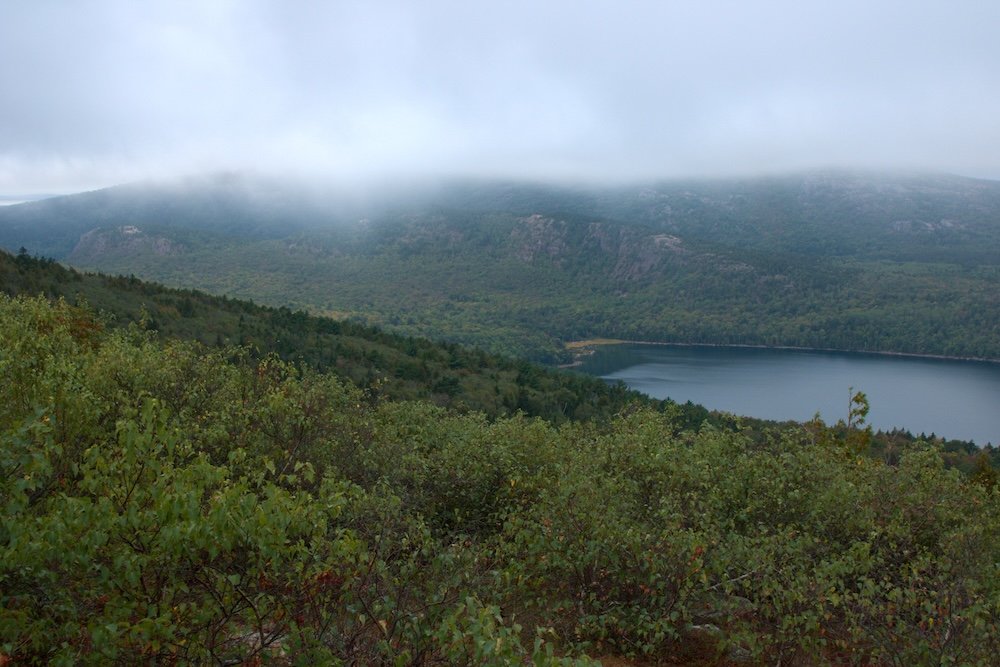
Otter Cove Bridge
My last stop for Park Loop Road is a stop that I didn’t anticipate making. As I drove along, I found a pullout near Otter Cove Bridge (which is not too far from the Otter Cliffs area). Because it’s just an pullout (though you can park your car and walk out a bit), a visit can be quick.
I don’t know what it is about this area, but this stop had some of my favorite views of the day. Between the views of the ocean, the mountains, the trees, and the bridge itself, the area was very photogenic and as I came up to it and saw there was a place to stop, I made the impromptu decision to get out and take some photos. I’m glad I did, so it gets a spot on this list.
How Long Do You Need at Acadia National Park?
At a minimum, you’ll need one full day at Acadia National Park. This gives you enough time to see the main sights along Park Loop Road and get in a few short hikes.
With two days at Acadia National Park, you can go a bit further. On your first day, spend your time exploring Park Loop Road. Then on your second day, branch out into some of the lesser visited areas of the park. I recommend the Beech Cliffs, Flying Mountain, and Bass Harbor areas.
If you have more than two days, you’ll still have things to do including visiting the small islands nearby. That said, if it were up to me, I’d spend my additional time exploring elsewhere in Maine. Acadia is beautiful, but so is much of Maine.
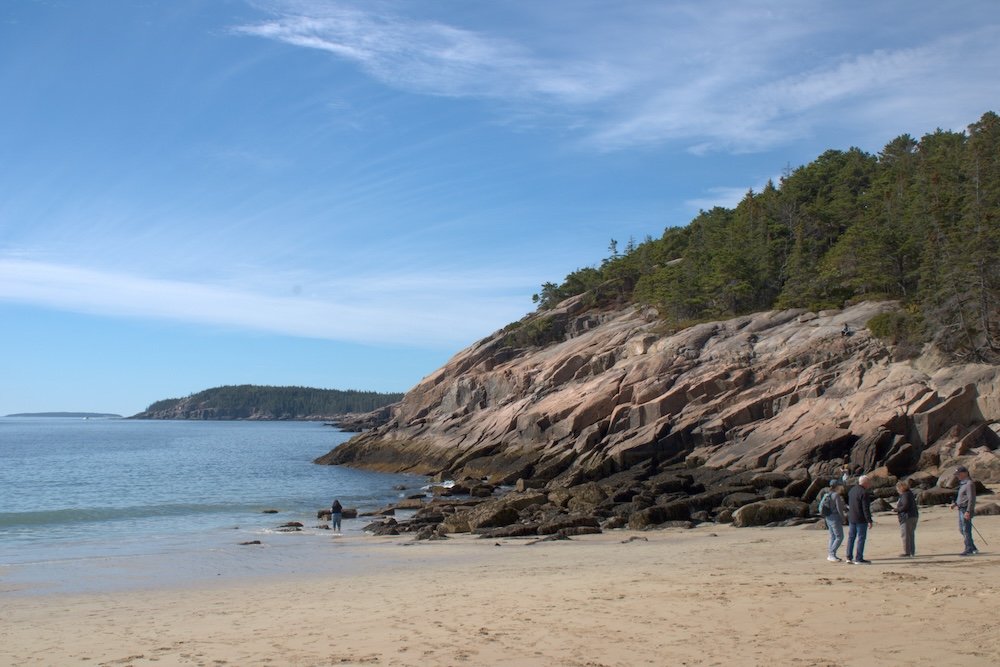
Entrance Fees for Acadia National Park
Entrance to Acadia National Park costs $35 per vehicle and your pass will be valid for seven consecutive days. Annual passes, such as the America the Beautiful pass are also accepted.
Note that visiting Cadillac Mountain Road comes with an additional fee. To visit Cadillac Mountain Road, you’ll need to pick up a reservation which comes with a timed entry. You can stay as long as you want, but you must have a valid entrance ticket in order to be permitted to drive up the mountain. Reservations cost $6 per vehicle.
Getting Around Acadia National Park
Acadia National Park surprised me with its transit system. While many national parks through the United States force visitors to have their own form of transportation, Acadia is different. You can bring your own vehicle, but if you don’t have a vehicle, you can still get to most places in the park.
A handy shuttle service connects Bar Harbor and Acadia National Park. Then within park, additional shuttles help to move visitors around. In total, there’s 11 lines that take visitors to all of the main sights throughout Bar Harbor and Acadia National Park. And the best part? This shuttle is completely free thanks to a massive donation that LL Bean makes to Acadia National Park each year.
Where to Stay at Acadia National Park
Bar Harbor is the closest town and sits right outside Acadia National Park. This is where most visitors stay as it’s the most convenient. You’ll have about a 15 to 20 minute drive to Park Loop Road. That said, prices for hotels in Bar Harbor are understandably high. Make sure to budget accordingly.
I travel on a budget so my accommodation situation looked a little different. I spent the night in Bangor, which is about an hour and a half away from Acadia National Park. I left Bangor early in the morning and spent the day exploring Acadia National Park. Then I spent one night in Bar Harbor since I had tickets for sunrise at Cadillac Mountain the next morning. After a second day of exploring Acadia National Park, I drove back to Bangor where hotels were cheaper.
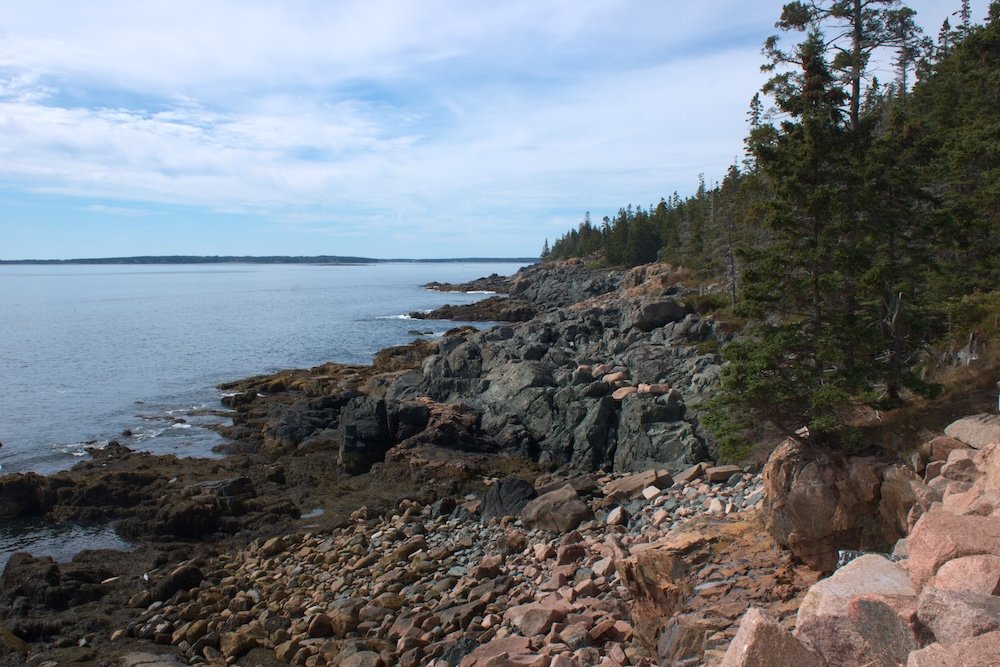
When to Visit Acadia National Park
Acadia is best visited from May through October as this is when the top sights are open. During the winter months, you can still visit Acadia National Park, but some roads close and the hiking can become dangerous.
In summer, you’ll have the warmest weather, but you can also expect a decent amount of tourists. In many places, as it gets later in the season, crowds thin out, but this is New England which is famous for its fall foliage. In late September and October, you can expect big crowds who come not just to see Acadia National Park, but also to see all the bright fall colors.
I visited in mid September and had really great weather. The trees had barely started to turn colors so if it’s important to you that you see the fall colors, I’d recommend early October. That said, there’s no guarantee when you’ll get peak colors as it changes slightly every year based on weather.
Final Thoughts
Acadia’s Park Loop Road provides and excellent spine for sightseeing since many of the top spots are located right along this road. While I will always recommend exploring further, Park Loop Road is a fantastic introduction to Acadia National Park.
Continue Your Adventure
Acadia National Park: Tackle the popular Beehive Trail or simply hike around Jordan Pond. While much of Acadia National Park is rocky, here’s my favorite easy hikes. Loop the highlights of Acadia together in this one day itinerary or if you have more time, try my two day itinerary.
Maine: In Portland, cruise the islands on a Mail Boat Tour. Nearby Portland is Cape Elizabeth which is home to the most photographed lighthouse in the United States. Learn more in my Maine Travel Guide where you’ll also find my five day Maine itinerary.
More in New England: Maine is just the beginning of adventures in New England. In Rhode Island, tour the over the top mansions in Newport. In Connecticut, visit the historic fishing village of Mystic or one of its many state parks. Take a quick detour through New York to visit Albany. And don’t miss out on Stowe, Vermont – it’s a favorite among many travelers. Loop together these highlights in a great itinerary in either 10 days or one week.
US National Parks: Start planning your national park vacation with my US National Park Travel Guide. You’ll find information about each park, photos, itineraries, budget tips, advice for non-hikers, the best scenic drives, and more. Plus, don’t forget to book your timed entry reservations in advance!
